The Amish & Steam Engines (9 Photos)
One of the few places you might find an Amish person “behind the wheel” (see below) is at the various steam engine shows taking place in Amish areas.
Today a reader shares photos from the annual event of the Northeast Indiana Steam and Gas Association, “a group of people who are interested in preserving and sharing…the engines, implements, crafts, and activities of America’s past.”
This was the 32nd edition of the show, held last week in Lagrange County. The reader says he “was surprised how many Amish individuals were operating steam engines.”
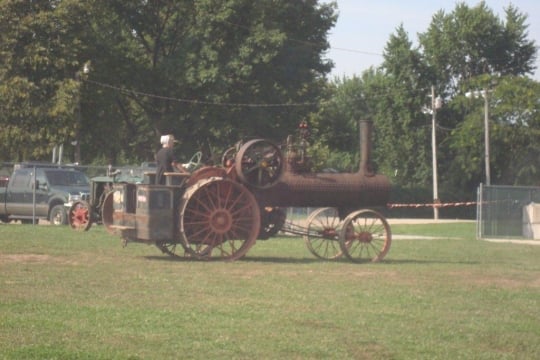
Amish have a fondness for steam engines. There are historical ties to the old technology:
By the late 1880s large steam engines operated threshing machines on many Lancaster County farms. Small gasoline engines were widely used by the turn of the twentieth century to saw wood, grind feed, pump water, and power washing machines. Like their neighbors, the Amish owned and operated steam and gasoline engines and used horses to pull machinery in their fields. (Donald Kraybill, The Riddle of Amish Culture, p. 222).
Today many Amish derive power from conventional tractor engines, though they are not often operated in fields.
Amish Use of Steam Engines
Amish continue to use steam engines in limited ways today. There is the steam engine ice cream freezer which you may have seen at Amish auctions. This past June I learned firsthand some of the interesting ways they can be used, on a visit to an Amish friend’s organic farm. One morning I found myself awoken abruptly by the 6 AM shriek of a steam engine whistle–piercing through the 33 decibel-rated earplugs I usually wear while sleeping as if they weren’t even there.
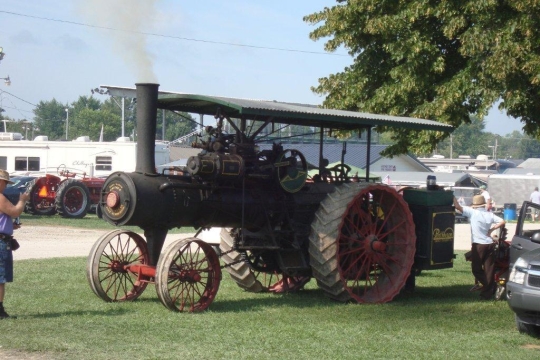
My friend happened to have a pair of steam engines on his property, and they were gearing up for work. Surely they had a task more important than serving as an industrial-strength alarm clock? They did: steaming the ground in order to kill weed seeds. Their Old Order Mennonite owner-operators later told me they provide the service for around a dozen farms in the area.
The engines generate ultra-hot steam which is transferred into the rows of earth via long metal pans. The pans get so hot, I was told, that were you to touch them, they would brand you. This treatment apparently does the job without use of chemicals. There is a history of doing this in tobacco fields, though this farm is strictly produce.
If you’re wondering, the engines have wheels for a reason. These machines can move, at a blistering rate of 2 or 3 miles per hour. It would take the young men around an hour and a half to travel the 4-5 miles home. They said they preferred traveling at night, for some reason which I didn’t quite catch.
I don’t know much about them, but I’ve often thought steam engines a little like works of art, in both their design and often vibrant paint schemes. They certainly are artifacts of the past. The ones treating my friend’s farm were around a century old. Despite their age, they were in good working order, including the three whistles of varying, but all shrill, pitch.

Steam Engine Shows
There are other steam engine events on the calendar in Amish areas. If you’re in the Lancaster County area this week, the 65th annual Rough & Tumble Thresherman’s Reunion will be held beginning this Wednesday through Saturday (August 14-17) at Kinzers, PA.
This event, which showcases steam engines among other farm implements, is very popular among Amish. On a previous post, Paul Long shared this on the Thresherman’s Reunion:
This engine show dates back to when the newest equipment was being shown to engine men and threshers. There is a traction engine parade as well as antique tractor parade, a steam traction engine rodeo in an arena, sort of like tractor pulls doing tricks with the engines as well. Usually 15 or 20 engines and road rollers fired up at once for the week there.
Doughty Valley Steam Days is another steam engine event, held annually in Holmes County, Ohio (this year’s event has passed).
NEISAGA Event Photos
We close with a few more shots from the show in Lagrange County. Note the three whistles visible in the first pair of photos. How many times did this young man let ‘er rip?


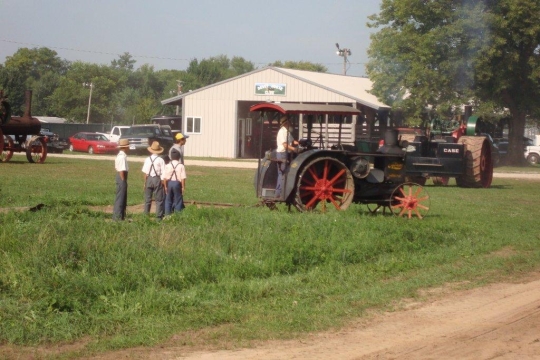



Enjoy this post? Support Amish America the next time you buy something from Amazon. It’s free and easy, and helps keep the posts coming. Here’s how.


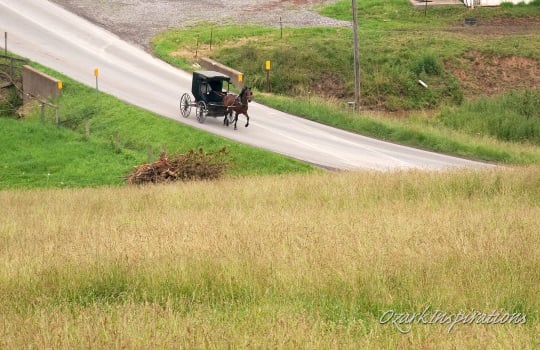





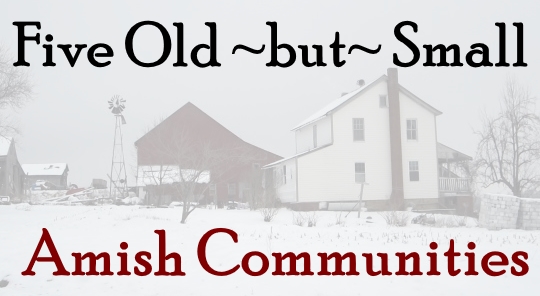
7th Pic
The tractor shown in the seventh picture is a Rumely Oil Pull tractor, I believe they ran on kerosene. My father spoke of them when we visited an antique tractor show years ago. Thanx for the nice pics and article! 🙂
Thanks Joe, wasn’t quite sure what that was, but to me the most interesting-looking machine in the batch.
Can you hear me?
Yikes, Erik! I hope you’ve retained most of your hearing after that ear-piercing wake-up call!
There was (don’t know if it still exists) a “museum” of sorts (on a farm about a half-hour’s drive from my house) about 25 yrs. ago that had a little of everything “old” (toys, cars, appliances, tractors & other “old-time” farm & home equipment). It was so interesting to see those old, massive, heavy machines. Only a couple were operable (at least, only a couple were “demonstrated”). It frightened me a lot to think of the damage (or worse) they could do to a body that got too careless around them.
Maybe it’s ’cause I’m a female (never was really “into” mechanics & such, which was just how it was back then), but when I was a little kid in the city, I actually thought that garbage trucks (which were so darn noisy to MY ears) were some kind of modern, terrifying DINOSAUR-machine hybrid. I remember running to my mother, covering my ears, in fear the “monster” would get me.
Interesting post & pix—especially about killing weed seeds with steam heat generated by a steam engine. I learn something new all the time, from this blog!
Alice Mary
You will ...
learn the most interesting things on this site! I was aware that steam had been used in some areas in the past to kill weed seeds. For the life of me I couldn’t figure out how they went about doing that. I would have never guessed that they used the steam from a steam engine tractor though.
There is a tractor dealer in the town about 15 miles south of where I live that has at least three or four very large pieces of antique farm equipment up under a shed on his lot. Iknow that one is an early horse drawn harvestor / thresher combine. Never took the time to investigate what all he has there, but recently I noticed what appears to be the nose of a J I Case steam tractor sticking out from under the shed. Not sure if it was there all along & I just never noticed it or if it is a new addition.
As far as I know he does not show these pieces and I am not sure if they actually run or not. I know the large shed that they are under has been there at least 30 years or more, because I use to buy parts from another tractor dealer that was immediately adjacent to his place and I remember seeing the shed and the antique equipment circe 1980 or so. Interest in that old stuff is still pretty strong. People that can actually remember how to sue it are getting rare though, at least where I live.
I have a couple of photos somewhere…very long pans with tubes piping the steam into them, they had handles by which they could carry the things and move them after steaming a section and not sear their hands (I think they steamed for around 20 min or so?). It did seem to me like an awfully big contraption just to get steam in the ground, and there were two of them. The fellows were at it for at least 2 days, I think they went through the night once. They had their bicycles along to be able to come and go from home.
Hmmmm ...
I’d like to have seen that. What is fascinating is the things that the old timers came up with.
Ear plugs and Alarm Clock
Erik, thanks for this story of awakening to another beautiful morn in Amish country. Hee hee; I’m still giggling as I write.
It felt like the engine was in the room with me. It was that loud. However it was probably at least 200-300 yards away, across a meadow. When they blew the whistle it echoed down the river. So I guess some other folks got a wake up call that morning too (the ones that weren’t up milking already, at least).
Early morning surprise
I remember when we were newlyweds living on a prairie farm in south central Texas and had a similar experience. It was the fall of the year on a cool, quiet Saturday morning and we had the windows open to enjoy the first blast of fresh fall air.
Our neighbor 3/8 to 1/2 mile south had an old John Deere tractor that he had been restoring, but so far had not fired up. At least not while we were at home anyway. It was of the series referred to by several nicknames; Poppin’ Johnny, Johnny Popper, etc. His was a “G” I think. Anyway, apparently he thought it was a good idea to fire this thing up about 6:00 AM and head to one of his winter wheat fields that he had plowed with his newer, larger John Deere so he could harrow the clods down before drilling in his wheat.
I heard it fire up and heard him idle it down the drive to the field in front of his house, but when he enetered the field and dropped the disc harrow he throttled it up & that thing just ROARED to life. My wife jumped straight out of bed and in sheer terror screamed “WHAT is that?”. I think she had visions of a nuclear attack or something. I had to laugh; “Don’t worry, it is just Charlie playing with his old John Deere”. She was not amused and none too happy with him for disturbing the peace.
If there is a show featuring Rumley oil pulls there will be Amish there.
Marcus Yoder
Daviess County Indiana
September 5 to the 8th we have a White River Valley Antique Tractor and steam engines and much more in Elnora Indiana. We have over 700 Amish families in our County and many visit the festival. We are less know of in our area and very laid back.
If that whistle you heard was as loud as the whistle on a steam train engine I once heard (as it was puffing into a small town — what a fantastic sight!), I’m surprised you still have any ears left. That has to be THE loudest sound I have ever heard! 🙂
What fascinating info about killing weeds with steam. My husband grew up in Minnesota farm country (a couple counties north of current Amish settlements in that area), and I’ll have to find out if he ever saw that done since there were a lot of oooold-time farmers he knew. (Garrison Keillor’s Norwegian Bachelor Farmers aren’t just a joke, they’re genuine!)
Anyone care to guess?
Anyone care to guess what make and series that tractor is in the background of the bottom photo? (The one with the plain couple up on the platform)
HINT: I think it was built between 1930 and 1937 & although it appears to be light gray in color with red wheels; I think it is actually green with red wheels. The apparent gray color had me thinking it was a McCormick Deering 15-30 or 22-36 series, but the steering linkage is not correct and there are a few other visible clues (especially on the left side of the engine) to make me think otherwise.
Any takers?